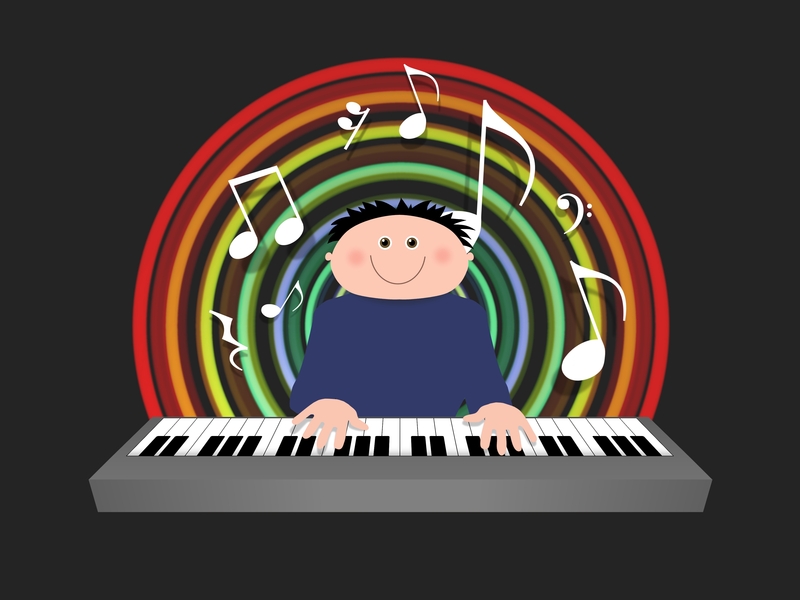The Useful Pianist: 3 - Inventing for everybody ... first steps RSS

everyone can improvise
Nobody who takes piano lessons from me is allowed to say that they can’t improvise. For a start, we don’t normally use that word, as it has such overtones of amazingness and unattainability. So I use the word “inventing” as an umbrella for any activity involving improvising, doodling, spontaneous mucking around, experimenting and composing.
In a normal piano lesson – probably not the last few before an exam – there is always room for a bit of inventing. It need not take long. (More about that in another article). Inventing forms part of the very first lesson I give to anybody (and indeed demo or trial lessons for people who are in the process of choosing a teacher). In that case I always start them off on the black notes. There is no need to think too much about technique; the main concern is not to slip off on to white notes. The pedal can be used to enrich the sound and the absence of semitones makes it almost impossible for the result to sound ugly.
Using the pentatonic scale
As the black keys create a pentatonic scale, two styles of playing are immediately accessible: “Chinese” and “Scottish” (they are in inverted commas to prevent mistaken notions of authenticity!). As I teach in Edinburgh, where the sound of bagpipes greets every traveller on alighting at Waverley Station, the sound of lilting 6/8 pentatonic melodies comes easily to mind. To the learner, it feels like being let in on a trade secret, when they discover what they can do by starting on a C sharp upbeat and moving up to an F sharp downbeat, then doodling around on the black notes in a dum ti tiddly rhythm!
adding an accompaniment
The next step is to add a drone left hand part. You can do this for them as a simple duet if they can’t manage both hands independently yet, or they can add it themselves. The black-note pentatonic scale can imply either E flat minor or F sharp major (of course neither scale is entirely there). So your drone can be F sharp and C sharp or E flat and B flat.
Make sure your student understands that these need to be the right way up – F sharp or E flat as the bottom note – to sound properly grounded. A drone can just hang on until it fades, or (with a bit more coordination) be repeated regularly, even acting as a counter-rhythm if they are really doing well.
taking things further
If you are already doing this and wanting to take things further, the possibilities branch out into a huge tree of potential. The key to effective inventing is a checklist rather like this:
1. Start with a gesture – a rhythmic pattern, a few notes, a chord – that you want to take further.
2. If, early on, you don’t like what you are doing, stop and try something else. You need to be enjoying yourself!
3. Use repetition. It means the music can be understood as a structure and enjoyed as something worth listening to.
4. Randomness is tedious to listen to. Patterns are satisfying.
5. At some point, do something new and different. This will stand as a contrasting section in your structure. Repeat this too, until you feel it is in balance with the rest of your piece.
6. There are no wrong notes, only unexpected ones. They should not be allowed to stop the music continuing. Pull a face if you must, but don’t stop playing and don’t “go back” and “correct”!
7. Know where you are in the phrase, by feeling it or counting. There is room for irregularity, of course, but not to the brink of randomness (see 4. above)
be supportive
Some learners do a lot of this instinctively. Others never manage any of it… these are the (young) ones who may well love “just doing random stuff” and that’s nice for them, but it is still pretty boring for you! But please do not ever discourage anybody from doodling randomly during the inventing part of the lesson, even if it is driving you bananas (this does not apply if they are supposed to be learning how to practise bar 9 of the exam piece!). Supporting their confidence and enjoyment at the piano is far more important than protecting your well-trained sensitivities. By all means tell them sternly not to hurt the piano if the doodling becomes bashing.
If somebody initially thinks a thing is not possible for them, and then they find themselves doing it, this is a powerful confidence booster, and a basis to encourage more attempts.
Next article: more about how to teach inventing in different ways and at all levels.